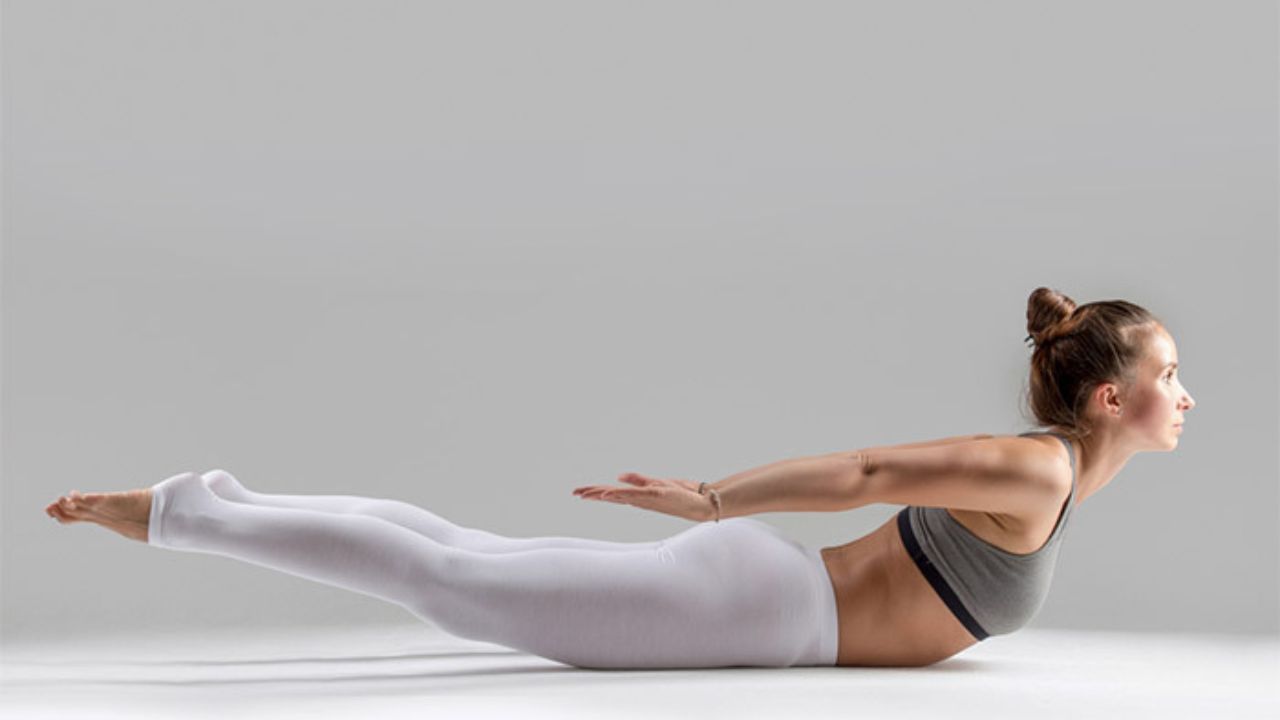Every once in a while, a gem from the yoga repertoire emerges, offering relief and revitalisation to our weary bodies. The Makarasana, echoing the stillness of a crocodile in repose, is precisely such a treasure.
Decoding Makarasana:
Deriving its name from the Sanskrit words ‘Makar’ (meaning crocodile) and ‘Asana’ (meaning pose), Makarasana or the crocodile pose is a rejuvenating yoga posture.
Why Embrace the Crocodile Pose?:
Beyond its resemblance to a tranquil crocodile, Makarasana is a powerhouse in alleviating shoulder and back discomfort. Its gentle stretch and restorative nature make it an excellent counterpose, often practised to neutralise the intensity of preceding asanas. For many, it’s the perfect curtain-closer to a rigorous yoga routine.
All You Need to Know About Makarasana
Essentials Before Diving into Makarasana
Before you venture into the tranquil realm of Makarasana, there are a few pivotal aspects to bear in mind. Traditionally, this pose serves as a cooling denouement to your yoga session, providing the body its much-needed reprieve. Ideally, embrace the freshness of the morning, with an empty stomach and cleansed bowels, to indulge in this pose. Yet, if dawn doesn’t find you on the mat, evenings are just as fine – simply ensure there’s a 3-4 hour gap since your last meal. And remember, if Makarasana is your sole focus for the day, a stringent empty stomach isn’t mandatory.
Level: Beginner
Style: Hatha Yoga
Duration: 2-5 minutes
Repetitions: 6 times
What it Strengthens: Spine, Shoulders, Arms, Chest
What it Enhances: Spinal resilience, flexibility, alleviates back pain and slip disc concerns. Indeed, it’s a haven for spine-related tribulations.
What it Stretches: Legs, Chest, Back, Glutes
-
Perfecting the Makarasana (Crocodile Pose)
Step 1: Begin by laying supine on the floor, basking in the cool touch beneath you.
Step 2: Elegantly fold your hands, allowing the elbows’ tips to gently kiss the ground. Ensure your fingers arch upwards in a graceful ascent, maintaining a shoulder-width distance between your elbows.
Step 3: Elevate your shoulders and head, channeling an elegant swan. Your neck remains poised and straight, with your gaze directed ahead.
Step 4: Gently tilt your head forward, cradling your chin within the warmth of your palms.
Step 5: Extend your legs, letting your toes point outwards, cherishing the feel of the earth beneath.
Step 6: Engage in slow, rhythmic breathing, letting each exhale untangle the knots of tension in your muscles.
Step 7: As you relish this pose, allow a few unhurried minutes to pass, immersing in the tranquillity it bestows.
Step 8: To gracefully bow out of this position, delicately lift your palms away from their chin perch, lower your shoulders and head, and softly roll over to your side.
-
Precautions to Embrace
While the serenity of Makarasana beckons, it’s paramount to ensure your body is at ease throughout the pose. If the shadows of a severe back injury loom, it might be wiser to give Makarasana a miss. For those with delicate necks, tread lightly. Allow your neck to remain neutral or cosset it with a softly folded blanket, offering tender support.
When grappling with profound injuries or lingering psychological shadows, sidestep this asana, and instead, find solace in meditative stillness. Crucially, if Makarasana is on your horizon, a nod from a physician, coupled with the guidance of a seasoned yoga mentor, is a must.
-
Nugets of Wisdom for Novices
Embarking on the Makarasana journey can be akin to finding sea legs. A little wobble here and a slight tilt there is quite normal. To aid your balance, let your hands be your anchors, gently assisting you to perfect the pose. Over time, with consistency, you’ll find equilibrium.
Remember, the soothing embrace of Makarasana, especially as a concluding act, might lull you into slumber. Embrace relaxation but stay present, resisting Morpheus’ call.
-
Elevating Makarasana: Advanced Twists
Ready for a challenge? Transition seamlessly to the Shalabhasana or the Locust Pose. Simply unfurl your palms from your face, reaching them forward, unbent, with palms whispering to each other. Dip your head, aligning your ears with your arms, then gracefully lift your legs, angling them at 60 degrees. Hold, breathe, revel.
Craving a deeper dive? Delve further into the Crocodile’s embrace. Elevate your legs, bending at the knees, and draw the soles of your feet toward your glutes. Ensure your pelvis stands proud, perpendicular to the earth. Then, surge upward, stretching your arms and reaching for the skies.
-
The Bounty of Makarasana
Makarasana, in its gentle repose, is a veritable treasure trove:
- A sanctuary for your spine and shoulders, offering them a restorative embrace.
- A healing touch for ailments like asthma, slip disc, spondylitis, and sciatica.
- A gracious stretch for the hips, dispelling any lingering stiffness.
- An elixir for fatigue, rejuvenating every fibre of your being.
- A bulwark against backaches, hypertension, heart ailments, and psychological tempests.
- An enchanting lullaby for your abdomen, chest, and neck muscles.
- A guide, leading you to breathe deeply, infusing wellness in every breath.
- A beacon of physical vitality and mindful awareness.
- A haven of tranquillity, dissipating anxieties and anchoring inner peace.
- A master key, unlocking flexibility and liberating the body’s constraints.
Dive into Makarasana, and let its myriad blessings cascade over you.
-
Laying the Groundwork: Preparatory Poses
To seamlessly glide into the embrace of Makarasana, it’s essential to prime your body. Here are the foundational poses that act as stepping stones:
Bhujangasana (Cobra Pose): This pose stimulates the spine, relieving stress and fatigue. It’s a perfect precursor, opening up the chest and strengthening the shoulders.
Gomukhasana (Cow Face Pose): An incredible stretch for your arms and shoulders, it helps in releasing the tension and making them more supple.
Sethu Bandhasana (Bridge Pose): Fortifying the back muscles, this pose ensures your spine is ready for Makarasana.
-
Evolving Your Practice: Follow-Up Poses
Post-Makarasana, as your body craves further exploration, these follow-up asanas can be your guide:
Dhanurasana (Bow Pose): This dynamic stretch accentuates the benefits of Makarasana, especially for the spine and chest.
Ustrasana (Camel Pose): This backbend further opens up your chest and deepens the stretch in your spine, complementing the effects of the Crocodile Pose.
Salamba Sarvangasana (Supported Shoulder Stand): A wonderful inversion, it revitalises the body, making it an apt progression from the relaxation of Makarasana.
Makarasana: A Reposeful Epilogue
Much like a resting crocodile, the Makarasana offers a serene sanctuary at the close of a yoga session. Beyond its tranquillity, the pose wields a healing touch, assuaging afflictions ranging from asthma to mental imbalances. It’s a panacea for fatigue and a bastion against ailments like slipped discs, spondylitis, and hypertension.
However, tread with caution if back injuries mark your past. Those with neck concerns, let a folded blanket offer tender support.
For optimal results, let the early morning, with its purity and an empty stomach, be your chosen time for Makarasana. As you evolve in your journey, you can also embrace the pranayama or even advanced variations of the pose, letting your practice be ever-fluid and ever-growing.
Frequently Asked Questions
- Is Makarasana a prone pose?
Absolutely. Makarasana requires you to be in a prone position, meaning you’ll be lying face down.
- Are Shavasana and Makarasana considered relaxation poses?
Indeed. Both these asanas are renowned for their ability to offer relaxation. They provide a gentle reprieve, soothing muscles, and nurturing a calm mind and spirit. Furthermore, they aid in dispelling stress, enhancing mood, and refining posture.
Key Takeaways
Rooted in Symbolism: In Makarasana, ‘makar’ translates to crocodile. This asana is typically embraced towards the tail-end of a yoga session, acting as a gentle buffer against stress.
Stretch & Strengthen: Makarasana offers a delightful stretch across the body while fortifying areas like the shoulders, arms, and chest.
The Pose Unveiled: Initiate by lying face down. Cradle your chin within the warmth of your palms, ensuring your elbows kiss the earth. Extend your legs, letting your toes gracefully point outward.
Repetitions & Duration: It’s ideal to engage in this pose for 6 cycles, with each lasting between 2 to 5 minutes.
Tread with Care: Those battling severe back ailments or grappling with profound psychological challenges should approach Makarasana with caution. Prior consultation with a medical expert or seasoned yoga practitioner is a must.
Evolving the Practice: As you deepen your connection with the pose, you can also explore its advanced variants and subsequent poses like Shalabhasana, Dhanurasana, and Ustrasana.









